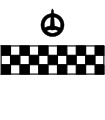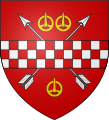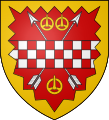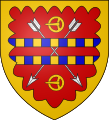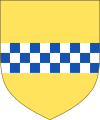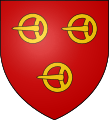Clan MacAulay facts for kids
Quick facts for kids Clan MacAulay |
|
|---|---|
| Clann Amhlaoibh | |
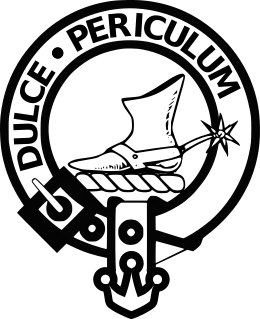
Crest: A boot couped at the ankle and thereon a spur Proper
|
|
| Motto | Dulce periculum |
| Profile | |
| Region | Highland |
| District | Argyll |
| Plant badge | Scots fir or cranberry |
| Clan MacAulay has no chief, and is an armigerous clan | |
| The Laird of Ardincaple | |
| Historic seat | Ardencaple Castle |
| Last Chief | Aulay MacAulay |
| Died | about 1767 |
Clan MacAulay (Scottish Gaelic: Clann Amhlaoibh) is a historic Scottish clan. The clan was based around Ardencaple Castle in what is now Rhu and Helensburgh, Scotland. This area is in Argyll and Bute, which is part of the Scottish Highlands. The MacAulays of Ardincaple were often seen as a "Highland clan." They were also linked to the original Earls of Lennox and later to Clan Gregor.
The MacAulays of Ardincaple were traditionally part of a group called Siol Alpin. This group of seven clans believed they were descended from Cináed mac Ailpín, an early King of the Picts. The leaders of Clan MacAulay were known as the Laird of Ardincaple.
Clan MacAulay's history is clear from the 1500s. They were involved in many conflicts with other clans. However, their power decreased in the 1600s and 1700s. The clan became inactive after the last chief, Aulay MacAulay, died in the mid-1700s.
In the 1900s, people became more interested in Scottish clans. A movement started to bring Clan MacAulay back. This group tried to unite different MacAulay families under one chief. In 2002, they chose a potential chief. But the Lord Lyon King of Arms, who handles Scottish heraldry, did not officially recognize him. The Lord Lyon said a chief must have a direct family link or serve as a Clan Commander for ten years. He also noted that this chiefship was only for the MacAulays of Ardincaple, not all MacAulays. Today, Clan MacAulay does not have an officially recognized chief. This means it is an Armigerous clan.
It's important to know that many MacAulay families from Ireland and Scotland are not related to Clan MacAulay. For example, the Macaulays from the Isle of Lewis and Uist in Scotland are different. In Ireland, the McAuleys from County Offaly, County Westmeath, County Fermanagh, and the "MacAuleys of the Glens" in County Antrim are also separate. However, the "MacAuleys of the Glens" might have originally come from Scotland.
Contents
Where Did Clan MacAulay Come From?
Clan MacAulay, or the MacAulays of Ardincaple, first appeared in Dunbartonshire. This area was controlled by the Earls of Lennox in the Middle Ages. The Gaelic name Amhlaíbh was used by members of the Earls' family. The surname MacAulay comes from the Gaelic Mac Amhalghaidh, meaning "son of Amhalghadh."
One person named Amhlaíbh was a younger son of Ailín II, Earl of Lennox. He and his family were lords of Faslane and a large area near the Gare Loch. The main home of Clan MacAulay was Ardencaple Castle. It sits on the Gare Loch, in what is now Rhu and Helensburgh. The name Ardincaple means "cape of the horses" or "height of the horses" in Gaelic.
Long ago, the Ardincaple estate had two main homes: one at Ardincaple and another at Faslane. The site of Faslane Castle can still be seen by a small mound near a stream. There was also a legend about an old oak tree at a place called Cnoch-na-Cullah (Knoll of the Cock). People believed that if a cock crowed under this tree, a MacAulay clan member was about to die.
The exact family history of Clan MacAulay is not fully known. The clan chiefs were the Lairds of Ardincaple. Some historians, like Alexander Nisbet in the 1700s, believed the clan came from Morice de Arncappel, who lived in 1296. Nisbet said that the family later changed their name to MacAulay from an ancestor named Aulay.
The name Ardincaple as a surname became common in the 1400s. Records show people like Johannes de Ardenagappill in 1364 and Arthur de Ardincapel around 1390. In 1489, Robert Arnegapill was pardoned for holding Dumbarton Castle against the king. Later, Aulay Arngapill of that Ilk is mentioned in 1513. Historians believe the first Laird of Ardincaple to use the surname MacAulay was Alexander de Ardincaple. He was the son of Aulay de Ardincaple and lived during the reign of King James V (1513–1542).
Clan MacAulay's History and Conflicts
In the 1400s and 1500s, clans in west Dumbartonshire often fought. The MacAulays, MacFarlanes, and Colquhouns raided each other's lands. They also worked together to steal livestock from the lowlands. Other clans, like the MacGregors, Campbells, and Buchanans, also came into the area later.
In 1567, after Mary, Queen of Scots, gave up her throne, Walter MacAulay of Ardincaple signed an agreement to protect her young son, James. In 1587, "The Laird of M'Cawla of Ardincaple" was listed as an important supporter of the Duke of Lennox. By 1594, the "M'Cawlis" were listed as a "Broken Clan," meaning they were considered troublesome.
Conflicts with Clans Buchanan and Galbraith
In the 1500s, Clan MacAulay often clashed with Clan Buchanan and Galbraith. On August 1, 1590, Walter MacAulay was killed in Dumbarton during a fight with the Buchanans. His brother, Duncan MacAulay, was also badly hurt. Other clan members were wounded too. The Buchanans involved were later declared rebels.
In May 1591, Aulay MacAulay of Ardincaple and Alasdair MacGregor of Glenstrae signed a "Bond of Manrent." This was a formal agreement where they promised to help each other. Ardincaple even recognized Glenstrae as his chief. This bond gave the MacGregors some relief from their enemies, the Buchanans and Galbraiths.
In 1593, Robert Galbraith, Laird of Culcreuch, got a special legal order to hunt down Clan Gregor. However, the MacAulays and Colquhouns thought Galbraith's real goal was to attack them. They complained to the Privy Council. It turned out that Ardincaple had married Galbraith's widowed mother, and Galbraith was very angry about it. The Duke of Lennox then took away Galbraith's legal order.
The Bond of Manrent between Ardincaple and Glenstrae in 1591 was very important. In it, both chiefs said they were from the same family: "M'Calppins of auld." This led some historians, like William Forbes Skene, to believe that Clan MacAulay was part of Siol Alpin. This group of clans claimed descent from Kenneth MacAlpin, Scotland's first king. However, later historians suggested that powerful clans like the MacGregors might have forced weaker clans, like the MacAulays, into such agreements.
After the Battle of Glen Fruin in 1603, the MacGregors were outlawed. It became a crime to even have the name MacGregor. The Earl of Argyll was tasked with enforcing the law against them. He suspected Ardincaple of helping the MacGregors. Ardincaple was accused of bringing MacGregor "rebels" to the Colquhoun lands and stealing from them. However, the Duke of Lennox again helped Ardincaple. King James VI declared Ardincaple innocent and took him to England.
Alasdair MacGregor of Glenstrae was captured in 1604. In his "confession," he claimed that Argyll had tried to convince him to kill the chief of the MacAulays. Glenstrae said he refused because of his promise to MacAulay.
Argyll's Conflict with Ardincaple
Archibald Campbell, 7th Earl of Argyll had a strong rivalry with Aulay MacAulay of Ardincaple. Argyll's men, led by Duncan Campbell, Captain of Carrick, tried to kill the MacAulay chief. In 1598, Campbell of Carrick had to promise not to harm Ardincaple.
In 1599, the Duke of Lennox removed some Campbells from lands near Ardincaple. In revenge, the Campbells of Carrick and Drongie attacked the Duke's new lands. They destroyed houses and stole livestock. The Privy Council declared them rebels.
In 1600, there were two attempts on Ardincaple's life. In one attack, Malcolm Galbraith, a follower of Ardincaple, was killed. In another, Ardincaple himself was shot. The Captain of Carrick and his men were again declared rebels. Later that year, Carrick's force invaded Ardincaple's lands, taking prisoners and destroying property.
Clan MacAulay After 1600
After the conflicts of the early 1600s, Dumbartonshire became more peaceful. The MacGregors lost their power, and the MacAulays, MacFarlanes, and Buchanans also became less powerful. Their lands slowly passed to others.
In 1614, Sir Aulay MacAulay of Ardincaple helped the Bishop of the Isles try to take back Dunyvaig Castle. In 1639, Covenanters took Dumbarton Castle. The Earl of Argyll put Walter MacAulay, Laird of Ardincaple, in charge of the castle with 40 men. In 1648, Aulay MacAulay helped create the parish of Row (now Rhu). He built the first church and provided land for it.
During the Glorious Revolution of 1688, James II of England was overthrown. William III became king. In 1689, Archibald MacAulay of Ardincaple raised a company of soldiers to support William. By 1690, "Ardencaple's Company" was led by Captain Archibald MacAulay. In 1696, MacAulay of Ardincaple was chosen as Captain of a local militia company.
In the early 1700s, some MacAulays moved to Caithness and Sutherland. They claimed to be descended from the MacAulays of Ardincaple.
MacAulays in Ireland
In the early 1600s, Clan MacAulay was involved in the Plantation of Ulster. This was when Scottish settlers moved to Ireland. Several MacAulays moved from Scotland to Ulster. In 1610, Alexander MacAulay of Durling received 1,000 acres of land in County Donegal. By 1619, he had built a stone house and had tenants who could provide 30 armed men. Alexander MacAulay later sold his land to Alexander Stewart. This Alexander MacAulay also became Laird of Ardincaple and chief of Clan MacAulay.
A branch of the MacAulays of Ardincaple also settled in County Antrim. They owned the Glenarm estate for a time.
The Clan's Decline and Modern Revival
From the 1600s to the 1700s, the power of Clan MacAulay and the Lairds of Ardincaple slowly faded. The lairds had to sell off their lands piece by piece. Ardincaple Castle, the clan's home, fell into ruin by the 1750s. The last chief, Aulay MacAulay, died around 1767. He had no land left and no heir to take over as chief.
Most of the Ardincaple estate eventually went to John Campbell, 4th Duke of Argyll. In 1794, Lord Frederick Campbell oversaw the draining of the marshy lands that once belonged to the MacAulays. Much of the land was so bad that it couldn't even support a cow.
Since the last chief's death, the MacAulays of Ardincaple have not existed as an active clan. There is no official clan chief today. However, in the 1900s, there was a new interest in Scottish clans. Several MacAulays tried to prove they were related to the last chief. A movement started to bring the clan back.
In 1997, Iain McMillian MacAulay became the temporary leader, or clan commander. In 1998, the clan organization decided to unite three different MacAulay groups under one chief. This new chief would lead all MacAulays. In 1999, MacAulay wanted to be recognized as chief, but another person, Iain Davidson MacAulay, claimed a direct family link to the chiefs.
In 2001, a special meeting called a derbhfine was held. It was supervised by the Ross Herald, a Scottish heraldry official. The meeting nominated Iain McMillan MacAulay to become the recognized chief. He then asked the Lord Lyon King of Arms for the right to use the official arms of the last chief. However, in 2002, the Lord Lyon, Robin Blair, rejected his request. He said that a person without a direct family link to a past chief must serve as Clan Commander for ten years first. He also stated that there was no strong evidence linking the Macaulays of Lewis to the MacAulays of Ardincaple. So, the petition could only be considered for the Ardincaple MacAulays.
After this, clan members decided to choose a chief democratically. A potential chief would be elected for five years at a time. After Iain McMillan MacAulay died in 2003, his son, Diarmid Iain MacAulay, was elected by members as chief.
The Clan MacAulay Association in Scotland held a "clan gathering" in Edinburgh in 2009. In 2011, Hector MacAulay was elected "Chief of the Clan MacAulay Association." An "International Clan Gathering" also took place in Carnlough, County Antrim, Northern Ireland, in 2011. This was the first gathering outside Scotland.
Further gatherings were held in Crieff in 2013 and Oban in 2015. The 2017 gathering was again in County Antrim, Northern Ireland, with nearly 200 people attending. The next Clan Gathering is planned for Aviemore, Scotland, from September 5 to 8, 2019. More details can be found on the clan's website.
Many McAuleys (and similar spellings) in Ireland today are not related to Clan MacAulay of Ardincaple. There are several other native Irish clans or families with similar names that have no historical connection.
- The Mac Amhalghaidh family from County Offaly and County Westmeath gets its name from the Old Irish Amhalgaidh. This family is native Irish and descended from Niall of the Nine Hostages. Their chiefs were known as "chiefs of Calry."
- The Mac Amhlaoibh family from County Fermanagh in Ulster gets its name from Amhlaoibh, which comes from Old Norse names. This family descended from Amlaíb (died 1306), a son of the first Maguire king of Fermanagh. They left their mark on the area in the name of the barony of Clanawley.
- The Mac Amhlaoibh family of County Cork is a branch of the MacCarthys. Many members of this family today use the name MacAuliffe. Their chiefs lived at Castle MacAuliffe near Newmarket, County Cork.
- The "MacAuleys of the Glens" are thought to be of Scottish origin. They lived in the Glens of Antrim and were allies of the MacDonnells in the 1500s. They fought alongside the MacDonnells against the MacQuillans in the Battle of Aura.
Clan MacAulay's Symbols
- Meaning of the Name: The clan's surname, MacAulay, comes from the Gaelic Mac Amhalghaidh. This means "son of Amalghaidh / Amhalghadh." The old Gaelic name Amalghaidh is pronounced like "Aulay" and its meaning is not fully known.
- Clan Member's Crest Badge: A clan crest badge usually has a chief's crest and motto. However, no chief of Clan MacAulay has ever had their coat of arms officially registered. The crest badge for clan members shows a boot with a spur. The motto is dulce periculum, which means "danger is sweet" in Latin.
- Clan Badge (Plant Badge): Clan MacAulay has two plant badges: cranberry and scots pine. Cranberry is also linked to Clan MacFarlane. Scots pine is linked to all seven clans of Siol Alpin.
Heraldry: Clan MacAulay's Coats of Arms
No official coat of arms for a Clan MacAulay chief has ever been registered. However, some old books show different arms for the MacAulays of Ardincaple. For example, one design shows two arrows crossed, with a checkered band and three gold buckles.
An early coat of arms was given to George M'Alla, a merchant from Edinburgh, in 1672. His arms were similar, with a checkered band, three buckles, and a border. His crest was a boot with a spur, and his motto was "danger is sweet." Even Thomas Babington Macaulay, 1st Baron Macaulay, a famous historian, used arms that looked like those of the MacAulays of Ardincaple. This was even though he was from the unrelated Macaulays of Lewis.
The checkered band and buckles in MacAulay heraldry likely come from the arms of the Stewarts. The Stewarts' basic arms show a checkered band. The buckles come from the arms of Alexander Boncle, whose daughter married a Stewart. Their descendants, including the Earls and Dukes of Lennox, used these buckles in their arms.
- MacAulay heraldry
-
The heraldic elements within the seal of Aulay MacAulay of Ardincaple, 1593 -
Thomas Babington Macaulay, 1st Baron Macaulay
(not registered at Lyon Court)
- Non-MacAulay heraldry
Clan MacAulay Tartans
Several tartans are linked to the MacAulay name.
MacAulay or Comyn/Cumming Tartan: This tartan was first shown as a MacAulay tartan in 1845. A very similar tartan was listed as a "Cymyne" (Comyn/Cumming) tartan in 1842. Later, in 1850, it was listed as a Cumming tartan.
MacAulay Tartan: This is a shorter version of the tartan above. It first appeared in 1881. It looks similar to the MacGregor tartan, which makes sense because the MacAulays were linked to the MacGregors. Some historians believe this is the true tartan of the MacAulays of Ardincaple.
MacAulay Tartan (1856): This tartan also looks like the MacGregor tartan. It was first published in 1856 with specific color patterns.
Hunting MacAulay Tartan: This is a more modern tartan. It is similar to the early MacAulay tartan from 1845. The Scottish Register of Tartans says this tartan dates from 1850.Families Connected to Clan MacAulay
The MacPhedran family is an official Clan Campbell family. Their name means "son of little Peter." An old account says that the first member of this family was a MacAulay. This family lived in Sonachan, near Loch Awe, which is Campbell territory. The MacArthurs of Darleith are also thought to be descended from the MacAulays of Ardincaple. Darleith is close to the old MacAulay home at Ardincaple.
Images for kids
-
Location of the Lennox in relation to Scotland.
-
Area of influence of Clan MacAulay within the Lennox.
-
A facsimile of the arms of "Mc: aula of Arncapelle".
-
The traditional descent of the seven clans of Siol Alpin.
-
R.R. McIan's Victorian era romanticised depiction of a member of Clan MacAulay. The tartan depicted is not the most common 'MacAulay' tartan today; but a tartan attributed to Clan Cumming.
-
Ardencaple Castle c. 1879, then occupied by H. E. Crum-Ewing of Srathleven, Lord Lieutenant of Dunbartonshire.
-
Ardencaple Castle, located near Helensburgh, Scotland. Today, all that remains of the grand turreted mansion is a solitary tower.
-
Allan M'Aulay, by Horace Vernet, 1823. M'Aulay holds the ... of Hector MacEagh, one of the "children of the mist".


